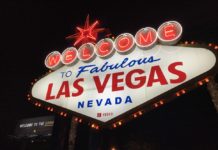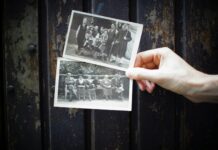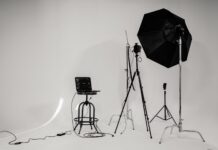If you are interested in Street Photography but are coming from a different genre or starting completely in the dark, you will probably notice very quickly that there is no easy way of improving and learning Street Photography. Since Street Photography is so diverse and requires a lot of different qualities, you need to find your own way of learning Street Photography. But which options do you have of getting better in Street Photography and what does fit you the most?
Learning Street Photography from Scratch?
Whenever I meet up with photographers from any direction, who tried their luck in Street Photography but feel more comfortable in portrait, architecture or landscape, they argue that they don’t have “the eye” or the character for Street Photographer. Therefore they lose the motivation to improve and rather stay in their comfort zone. They never even tried learning Street Photography but thought it would come easily on its own.
I find that rather sad and don’t believe that Street Photography can not be learned. Of course, there are some prerequisites that make it easier for you to become better very quickly, but all you need is hard work and investing time smartly. The difference between an amateur and professional in terms of quality can be found in the time they invested in their hobby as I already explained in “Talent vs. Training“.
Not to neglect the fact, that out of the billion people on this earth, there might be some super talented photographers that reached the top very easily and learned Street Photography by the way. But these are borderline cases that don’t have anything to do with the reality of photography.
In physics, your power output is described as Watt = J/s which describes the energy per second that you transfer. If you want to know how much power you generated you have to look at total output over time, for example, one day. To increase the total output you can either increase the energy you invest or simply work longer.
For our use, this means that to become a better photographer you either have to study longer or smarter. There is no other sure way than hard work and time and the same applies to all the other Street Photographers that you might look up to. They didn’t just pick up the camera one day and created the iconic images that you have in mind when going on the Street yourself. They were able to capture the pictures after investing a lot of time either photographing or doing something complementary.
This already hints, that to become better and learn Street Photography, you don’t necessarily need to spend all your time out on the street. Instead, there are a lot of activities that influence and help you to become a better photographer indirectly. Those I will describe in the next chapter.
To close the first segment I totally want you to encourage to learn Street Photography, even if you don’t feel confident that you will ever come close to your role models. Either way, you need to invest a lot of time and hard work in becoming better and everyone can do it if you are willing to.
This article will help you to use your time more efficiently and helps you to find out which works the best for you.
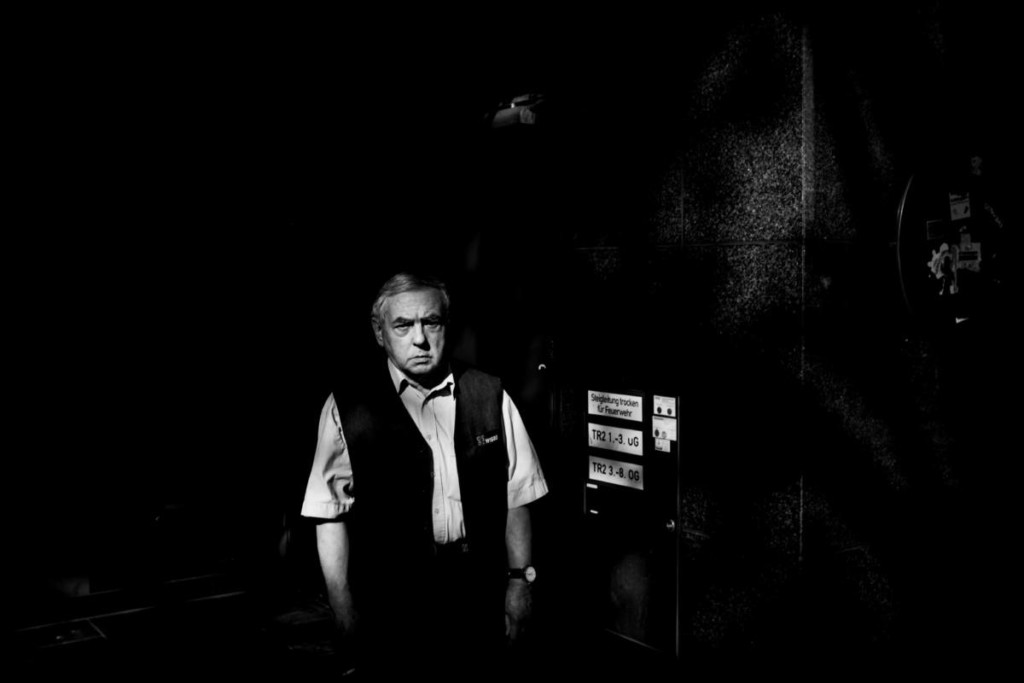
What to Learn in Street Photography
Street Photography combines a lot of different characteristics. Like I described my “perfect” Street Photographer as the combination of traits in “What does it take to be a good Street Photographer“, to become a wholesome Street Photographer you need way more knowledge than simply knowing how to expose an image correctly.
Therefore I break down the curriculum in two base categories.
The first classes will deal with photography itself in theory and practice.
The second classes will be about forming your personality and abandoning social restraints.
For an easier understanding, I will describe a Street Photographer’s abilities as if he were an athlete. In the sports universe, it is perfectly fine to break down one’s abilities in sub-categories like speed, physical, mental or accuracy depending on the sport we are talking about.
Therefore I created similar charts that describe the skills of a learning Street Photographer as if he were a video game character. I do understand that Street Photography can be expanded to infinite complexity, but to make it simple I will break down each category in five Skills and describe them.
Photography Basics
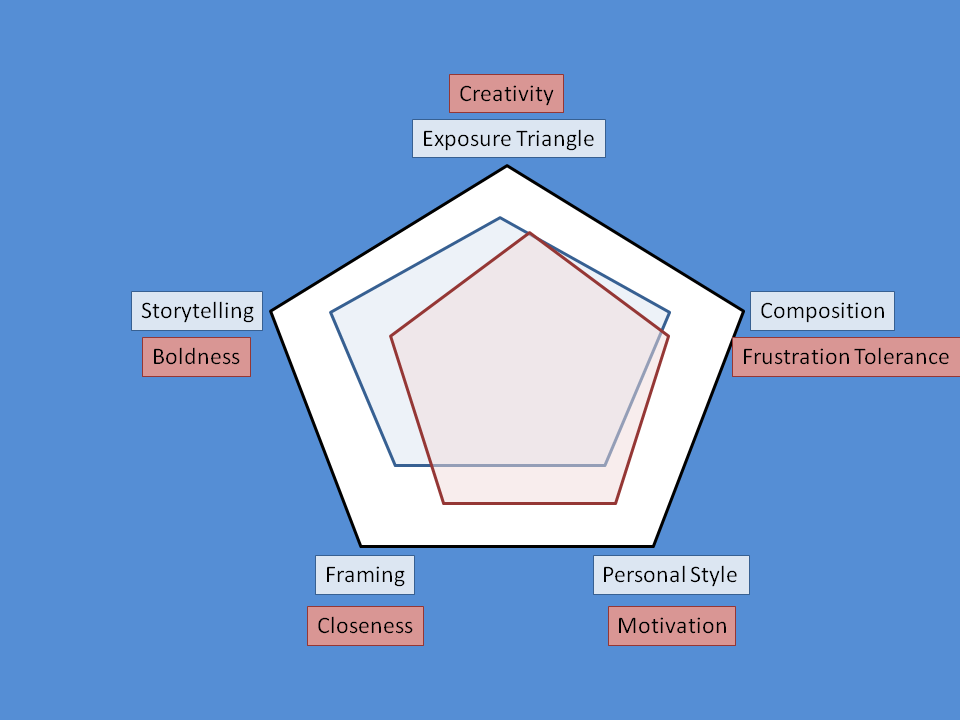
Exposure Triangle
The most basic thing in Photography is to expose the image correctly, or simply the way you want the final image to look like.
Luckily, modern cameras are already so advanced that you don’t need to manually expose every photo. It is no shame to use the smart automatic options and when you know what you are doing, they will come out fine.
Nonetheless, I’d recommend you to use the manual mode at first to learn how to expose difficult light situations. Under normal conditions, you are fine using a typical rule of thumbs like “f/8 and be there”. But what when you want to create silhouettes with the sun in the background or high contrast scenes in the dusk?
Learn how the aperture, speed, and ISO influence the exposure as well as the depth of field and blurriness during movement.
Being able to manual expose from the spot without needing much trial & error at the location helps you to correctly set-up the auto mode of your camera. Additionally, you will also find out which automatic mode suits you the most.
Framing
This term can be used in many different ways in Photography, but in this case, I want to describe, that you are able to determine the frame of your used focal length blindly. You are able to see the final crop of the picture without using the viewfinder.
In practice, you will be a lot faster when you know how close the 35mm will be through experience, rather than the viewfinder. You need a lot less time to adjust for the right distance and can snap the image right away.
One of the reasons why prime lenses are so popular is that experienced photographers don’t need the viewfinder anymore to compose the picture. Through years of working with the same focal length and photographing thousands of images, they exactly know how the frame will be.
For Street Photography, this is also a huge advantage when you are often shooting from the hip or want to be less conspicuous.
Composition
Let 10 photographers shoot the same scene and compare the results. Although they objectively capture the same thing, there will be still a huge difference in image quality. Some will simply look better than others.
The differences often aren’t very obvious and hard to describe, but many subtle changes in composition can turn an average photo into an award winner. Being able to arrange an image on the street in a way that it pleases the eye is one of the hardest parts about learning Street Photography.
In comparison to other genres, you don’t have the time to carefully arrange a picture on the Street. The composition has to be spot on for the first time since there often is no second chance.
Elements of the Rule of Thirds, Layering or Leading Lines have to become part of your identity. If you need to think about these things consciously while taking an image, this is an area where you can improve a lot.
After learning Street Photography and applying the natural rules on how to create visually pleasing images for a decent amount of time, you don’t need to actively think about them anymore, but rather use them instinctively in your photography.
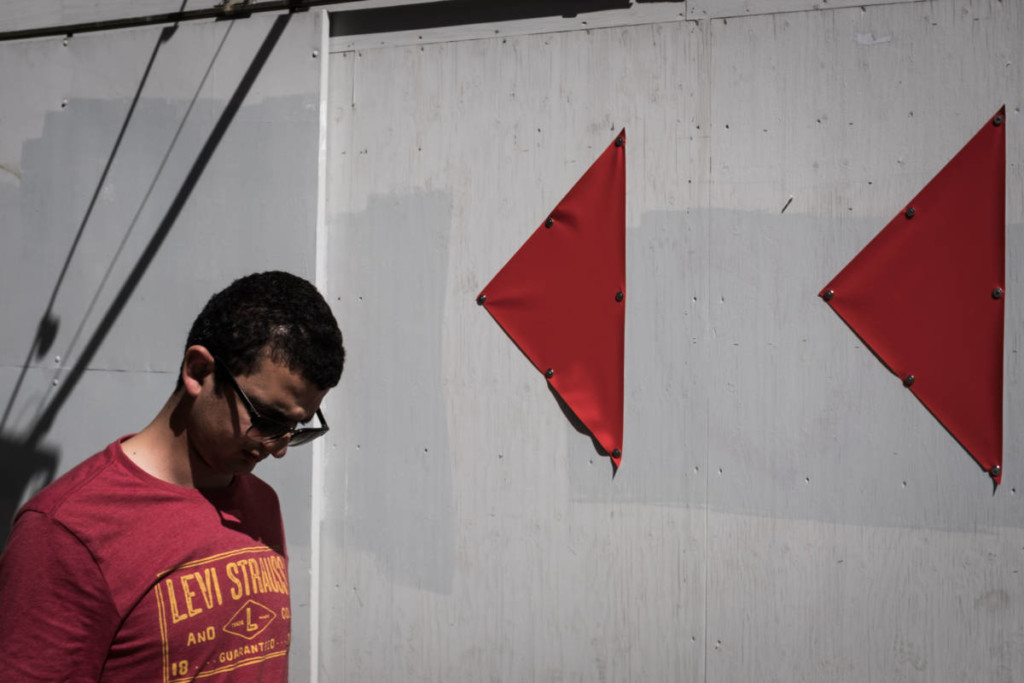
Storytelling
Photography is all about telling a story in one single frame or through a series of images. Street Photography mostly is about images that stand on its own merit and need to be able to tell the story in one image.
Documentary Photography, on the other hand, lives from a series of pictures which requires a different skillset.
Both combine, that you should be able to lead the viewer’s focus through the story you want to tell. Storytelling is probably the hardest part of photography. While composing the image you should have the story in mind and be able to describe it through your picture in a way that others can understand you.
Personal Style
Another long-term project apart of storytelling is developing your own style.
Street Photography has risen in popularity and more and more pictures are being shared on online platforms. Instead of an increase in diversity, it seems that the gross are getting more similar with every new image.
Understandably in a world with millions of pictures being created and shared it is hard to stand-out. Nonetheless, creating your own personal style where a viewer can quickly identify an image of yours is one of the long-term goals.
The combination of creativity, trial & error and hard work will make your pictures stand out from the mass.
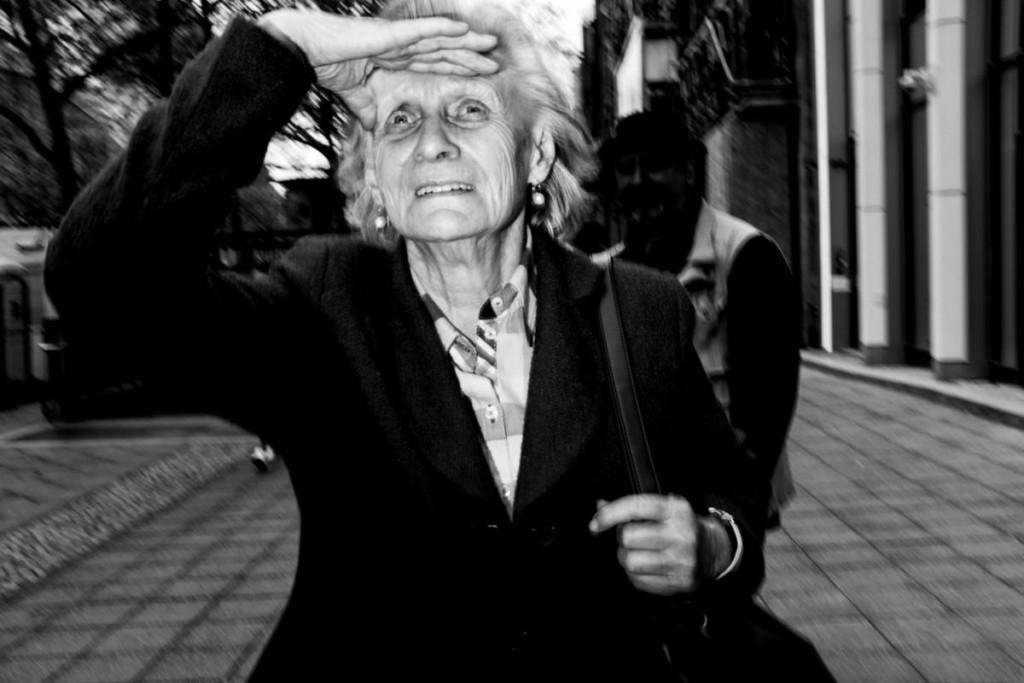
Character
Creativity
Often I find myself on the Street without any inspiration wandering for hours not getting any picture. In a city like Berlin, this is hard to believe and I often contemplate how other photographers would deal with the same situations. Would they be able to create beautiful photos out of scenes that haven’t been presented to me?
Creativity to me means, making the most out of every situation that passes by and to create completely new images.
Good Street Photographers are able to present a scene to its fullest potential.
Great Street Photographers are able to raise the potential of a scene simply by presenting it in their unique way, turning average situations into outstanding pictures.
Are you also able to innovate from time to time and create images that the Street Photography World hasn’t witnessed before?
Creativity itself is hard to learn, but understanding the craft of photography can help you to translate every little inspiration into creative pictures and makes learning Street Photography more fun.
Boldness
Do you stray away from taking an image because you are afraid of invading personal space?
Street Photography means to overcome your own comfort zone and behave outside the “social norm”. All your life you’ve been told to stay away from strangers and fit in with society.
Now that you are learning Street Photography, you have to unlearn those social boundaries and be self-confident to stand out. You practically own the street and have the right do to anything that you want to.
Being bold means to not miss any picture, but at the same time being so smart to assess situations you should stay away (yes they do exist).
Don’t let your creative freedom be interrupted by “educated fear”.

Closeness
Physical distance definitely plays a big role in learning Street Photography and I believe that most pictures improve by getting closer.
But closeness also has another big component, apart from the physical distance and that is how fast you “click” with your subject.
Are you able to get eye-contact that lets the viewer bond with the subject, or do your pictures have the long telelens feeling?
Being able to understand your subject, not shying away from eye contact and trying to show the true character is what closeness means in Street Photography.
Smiles and other masquerades are superficial, they often are fake and that’s why they are frowned upon by Street Photographers. Try to capture true candid moments where people aren’t able to pretend to be somebody else.
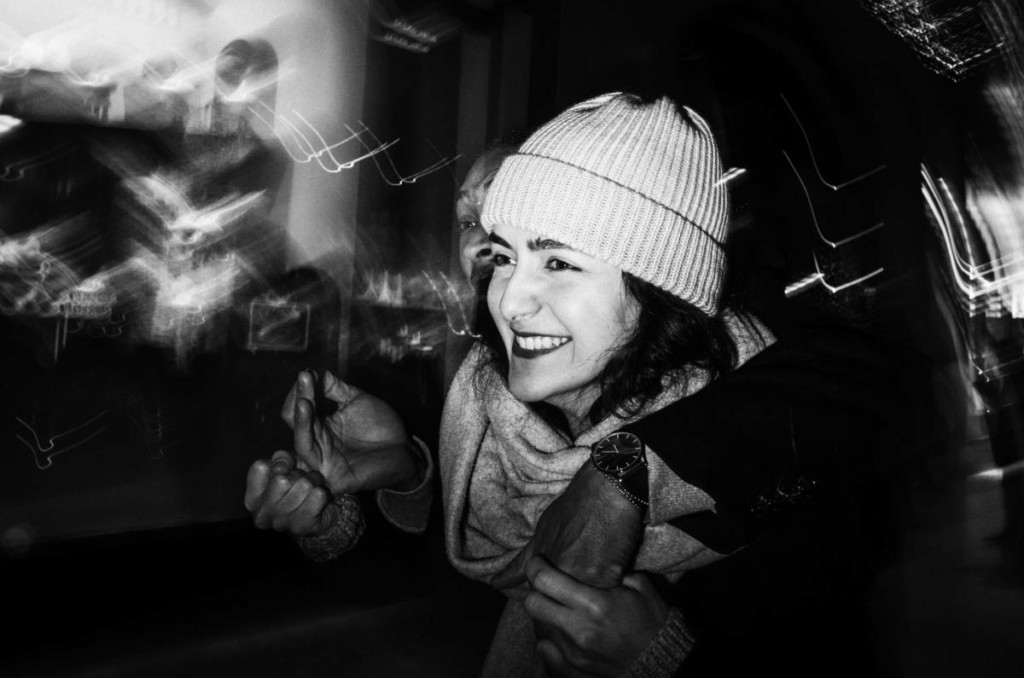
Frustration Tolerance
When I was in university going for my engineering degree I started with ca. 300 other students. After the first semester, already half of them quit. At the end, only about 50 saw the finish line and graduated with me.
It wasn’t that the other 250 weren’t smart enough to finish, but that they weren’t willing to go through the pain that failing exams means. Trust me, I probably failed more exams in the first run that I passed, but enduring these struggles and never giving up helped me to finally pass.
The same applies when learning Street Photography. Other than for example studio photography, the street is a place of uncertain events. No matter how good you are, there might be days that you just feel like you failed and didn’t bring any good results at home.
You simply have to build up a high frustration tolerance to enjoy Street Photography. Don’t let “bad” days bother you too much or demotivate you. Start the next day fresh and give your best without thinking about your failures.
If your poor results start getting in your head, it will help you to work on your mindset.
How fast are you able to shake off every bad experience and be able to focus 100% again on learning Street Photography?
Motivation
The last but also most important point on this list is the reason why you are actually shooting Street Photography.
There are a lot of simpler hobbies that can get you out of your house for a walk. Even in photography, every other genre offers faster and more gratification than Street Photography. So why bothering going the hard route instead of the easy pleasure path?
My motivation is to create something lasting and to express myself. Whether it was music, films or writing, for as long as I can remember I always tried to “create” something. Maybe because it is easier to communicate for me through pictures or written text, than through language?
Whatever your motivation is, you should really take a few minutes and think about why you are actually doing Street Photography. This will help you understand what actually is important in your photography and also elevate the development of your own style.
If you can’t find a strong answer, that will motivate you to go through all the struggles, then maybe you will find more joy in another genre? It is no shame to change directions, but Street Photography requires a very strong will and motivation to work on yourself. Otherwise, the results won’t simply come over time because Street Photography is too complex to learn it by the way.
How to Learn Street Photography
Isolating Areas
Previously I identified certain skillsets that Street Photographers need to build up to become a wholesome photographer. Like in any sports, you can get better by spending 100% of your time shooting on the street, like football teams could spend their training sessions playing 90 min matches all the time.
In reality, they don’t do that and instead focus on certain skills that they want to improve by performing specific exercises. Dividing your training sessions into small exercises with a clear focus on what you want to improve is a lot more efficient than doing everything all together.
When you are studying, you don’t just inhale everything at once, but rather divide the work into small chunks. Then focus on every smaller piece until you perfect them and put them together in the end.
Similar, musicians aren’t some geniuses than can remember thousands of individual notes. Every song consists of iterative patterns. Memorizing thousands of notes sounds unmanageable, but learning 4 patterns doesn’t feel so overwhelming now.
In Street Photography you can focus on specific skills by performing challenges or exercises, where the pictures themselves aren’t that important, but the task itself will help you a lot.
Are you having problems getting close to people? Then pre-focus your camera to 1 1/2 meters and use a narrow depth of field. Suddenly you will be forced to get close or otherwise every picture will be out of focus.
Are you not comfortable enough with a camera around your neck? Wear your camera everywhere, whether you are grocery shopping or just visiting some friends.
At first, a lot of these things might sound silly to you, but in the end, you can assemble every little piece together to become a better Street Photographer.

Photo Groups
One of the oldest forms of improving is joining a photo group or club with like-minded photographers that have the same goal.
I support this idea, I am part of the Berlin1020 collective where I found great people that helped me improve to the extent that I never was able myself. For example, I gained enough confidence to shoot with a flash on the street, something that I always wanted to try out, but didn’t have the guts to try it alone. After they introduced me to this technique, I now am able to do it on my own. Who knows how much longer I needed to push myself to that point without there support, if ever?
Finding such a group is definitely a huge help, but there are also a lot of red flags when you are searching for such a group in your area. Street Photography is a very small niche, so finding a group that fits you to 100% is like winning the lottery.
For example, when the photo club spends more time discussing cameras, gear or image quality it probably isn’t the best for you to improve and take better images. Unfortunately, the majority of photo clubs consists of presenting the newly acquired lens and pixel peeping, without focusing on what truly matters.
If you are searching for a group in your area, have a look at their portfolio and ask them to join the next time they are doing some Street Photography. While you are on the street spending some time with the group, don’t focus too much on taking pictures, but use the time to discuss photography topics that you are interested in. Even if their portfolio isn’t exactly what you are desiring, they might have gained experiences in certain areas that you can benefit from. So even if it is not a Group dedicated to Street Photography, if you feel that the people are inspiring and can teach you a lot, it might still be worthwhile to join them.
Otherwise, looking online for other Street Photographers in your area that you find inspiring and forming a group yourself might be something you could look forward to. Street Photography can be a very lonely fate, so a lot of people are very open about joining forces to meet regularly.
In case you have no one in your physical vicinity, creating a closed circle online with Street Photographers can help you a lot. The key is to keep it private and small. Public forums aren’t a place to seriously discuss Street Photography, they are a place to fish for compliments or promote your own profile.
Blogs
There are books about every topic you can imagine. Before the time of the Internet, I learned the guitar with the help of a book and even when I tried out skateboarding a book gave me a lot of ideas on how to do a simple ollie.
Now the Internet has replaced a lot of those books with fresh content. The great thing is, that there is a much bigger variety of online blogs with different focuses, writing styles and content. Whatever learning type you are, whether you learn better through written text or Youtube Tutorials, the Internet offers a lot more to offer when learning Street Photography.
On the other hand, it becomes increasingly hard, to filter out, quality content from garbage. Especially when you are not that proficient yourself yet, it becomes difficult to differentiate between experts and just talking figures.
Facebook Likes, Youtube Views, or Google Rankings give the illusion of credibility and quality. Yet, they are two separate things. When searching for good inspiration in Blogs, or Youtube Views, have a look at their Portfolio. Some even don’t publish their works, or just recycle the same 10 images over and over again.
I am not a fan of this approach and to be transparent with you I try to only include my latest works in my articles, so you are able to follow what I have been recently up to.
Anyway, here is a short list of Blogs that I can recommend for learning Street Photography. Whether it is the type of content you personally like is up to you, but they provide content from typical tutorials to picture stories or insightful blog posts.

Workshops
Recently, Workshops have risen a lot in popularity for teaching Street Photography. They require physical presence, are a time investment and also don’t come in cheap.
Ranging from a few hundred US-Dollar to a few thousand for a day or a couple of days, they are a real commitment and better be worth it.
But just like with blog content, which is at least free, there are a lot of teachers out there that sound like experts but aren’t even real Street Photographers.
Not to say that you need to be the best Street Photographer yourself, to be able to teach it to others. There are football coaches out there winning the Champions League that never participated in a Champions League game themselves. But you should be knowledgeable about the subject and have a decent experience yourself.
If a workshop tutor is teaching one thing to his group but privately following another direction, how can he be credible or trusted?
Before joining a workshop, I would thoroughly research the portfolio, especially the recent works, so you are able to see at which level he is now. It doesn’t matter if he got a few decent shots a decade ago, if he is out of shape now, the workshop might be hardly worth the investment.
Additionally, I would search for first-hand experiences and any type of content that is available, for example, if there is a lecture on Youtube and if it fits you.
Just like you don’t need to be the best Street Photographer to teach it, being an expert doesn’t automatically qualify you as a good teacher.
Also, keep in mind that there are a lot of different kinds of Workshop tutors out there. Some are more motivational, giving you a much-needed kick in the butt if you are too afraid to take pictures in public.
Others are more focused on the composition and teaching you the theory of Street Photography.
Whatever you are searching for, think about what the Workshop Specifications beforehand and research the instructor thoroughly, to find out if it is worth your time and money for learning Street Photography.
Conclusion on Learning Street Photography
Street Photography is not the type of “Easy to learn – hard to master” genres. It is difficult to learn and even harder to master.
Being able to control your camera is just the very first prerequisite for taking decent shots.
In this article, I divided and simplified learning Street Photography in twelve different skills that you might improve on individually. Further subdivided into photography skills and mental aspects.
If your goal is to improve as a Street Photographer, your time is more efficiently spent if you focus on improving specific areas, rather than trying everything at once.
Depending on what learning type you are, there are different ways of learning Street Photography. Either through blog posts, workshops or Photography Courses.
After all these tips, the most important aspect of becoming a better Street Photographer is to go out and shoot. Never lose the fun aspect of photography, work on the theory part, but at the same time don’t overanalyze Street Photography.
Meet up with Street Photographers you look up to, visit different locations and actively try to improve your mindset and photography skills.
There is no shortcut other than investing a lot of hard work, but at least the work can be enjoyable too and the results will follow soon.
Stay Curious
Sebastian Jacobitz



